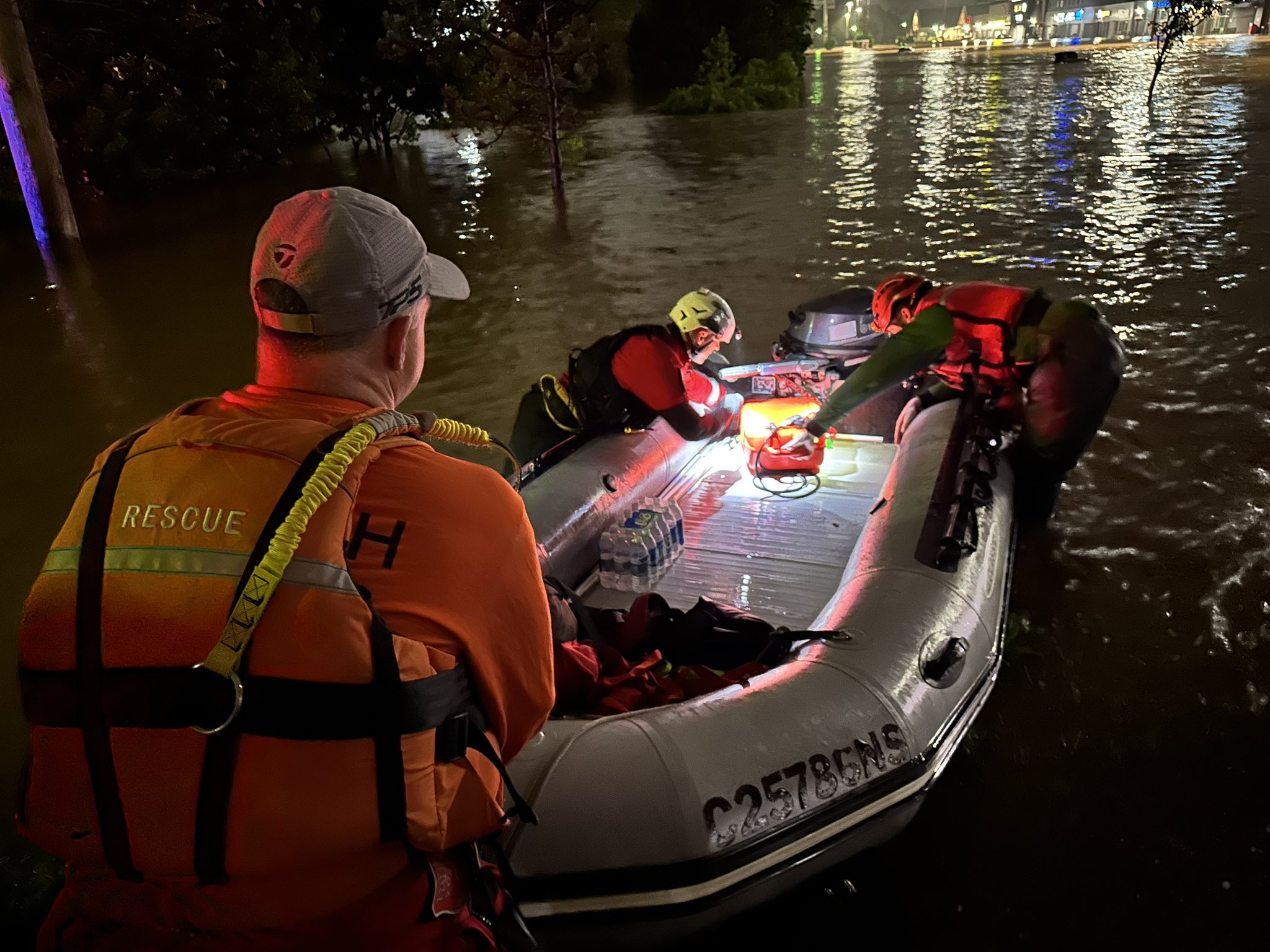What we’re watching: Weekly disaster update, July 24

We know all too well that disaster can strike anytime, anywhere in the world. Some disasters make headlines; others do not. Here at the Center for Disaster Philanthropy (CDP), we monitor the status of disasters worldwide and compile a list of the ones we’re tracking weekly, along with relevant disaster-related media coverage.
Here’s what we’re watching for the week of July 24, 2023.
New or Emerging Disasters
Flooding – Nova Scotia: Canada’s east coast province of Nova Scotia received up to 10 inches (25 centimeters) of rain in some parts, as much as falls typically in three months. The floods damaged roads, buildings, bridges and a Canadian National Railway track to Canada’s fourth-largest port.
A province-wide state of emergency was declared on July 22 until August 5. The declaration said East and West Hants, Halifax Regional Municipality, Lunenburg, and Queens counties were the most affected areas. On July 24, workers continued to pump water from a flooded area that is the focus of a search for four people who went missing. On July 22, authorities said about 750 people were ordered to evacuate the Halifax area, while more than 400 homes were evacuated in Lunenburg.
Flooding – Kentucky: Strong storms and heavy rain caused flooding in southwestern Kentucky on July 19, breaking the daily rainfall record, flooding streets, cars and homes, and knocking out power.
The National Weather Service (NWS) in Paducah said the 11.28 inches of rain that fell in Graves County broke a 24-hour rainfall record for the state. Governor Andy Beshear declared an emergency on July 19 in response to the flooding.
The town of Mayfield was among those affected and is still recovering from a devastating tornado in 2021. Farmers in the region are particularly affected after a dry start to the growing season has been followed by an intense period of rainfall.
Tornado – North Carolina: A powerful tornado swept through central North Carolina for more than 12 miles on July 19, damaging homes and injuring residents. NWS gave the tornado a preliminary rating of EF-3, making it the first EF-3 tornado observed in central North Carolina in July. There are reports that multiple mobile homes in the Dortches area were destroyed.
Pharmaceutical company Pfizer said the tornado damaged its facility in Rocky Mount. The drugmaker said the facility makes almost 25% of Pfizer’s sterile injectable medicines used in U.S. hospitals. The company is working with the Food and Drug Administration to determine the impact on the nation’s drug supply. The disaster could cause long-term shortages of some drugs at a time when the U.S. is already facing the highest number of active drug shortages in nearly a decade.
Landslide – Colombia: Heavy rainfall is believed to have triggered a deadly landslide on July 17 that swept away homes in Quetame, Colombia, a municipality southeast of the capital, Bogotá. Early reports indicate the worst-affected area is Naranjal, where rising waters destroyed at least 20 homes. According to authorities, the landslide killed at least 20 people, and more than 400 military personnel, firefighters and government rescue workers searched for survivors.
On The Landslide Blog, Dave Petley said, “Google Earth indicates that a large gully enters the main channel at this point that has multiple landslides on its slopes. This seems potentially to be the source of the disaster, but this is speculation at this time.”
Typhoon – China: Typhoon Talim hit southeastern China last week, displacing 230,000 people. Talim brought winds of nearly 87 miles per hour (140 kilometers per hour) to Guangdong province before landfall in neighboring Guangxi on July 18. Before landfall, authorities in Hainan asked ships to return to port and ferry services between Hainan and Guangdong were suspended.
In Vietnam, authorities said they evacuated about 30,000 people from the areas expected to be hardest hit in Quang Ninh and Hai Phong provinces. Talim made landfall as large parts of Asia are feeling the effects of heavy rain and extreme heat.
Wildfires – Greece: In the past week, wildfires have been burning nationwide, stoked by extremely dry conditions and heat waves. On July 23, firefighters battled fires on the island of Rhodes that trapped tourists and locals who were transported or walked to safer parts of the island. Some tourists praised the response and generosity of the local community, which was providing food and supplies.
Earlier in the week, two wildfires moved uncontrolled through forestland and towns northwest of Athens. According to officials, fires had burned homes and vehicles around Mandra, west of the capital. Houses and a small shipyard were also reportedly damaged in the town of Neos Pontos. Another fire that broke out on July 17 in the Corinth area damaged at least 30 houses.
Dr. Matthew Agarwala, an economist at the University of Cambridge focusing on climate change, told the BBC that while humans are skilled at adapting, climate change is pushing people in Greece “beyond the limits of what they can adapt to.”
Wildfire – Algeria: At least 97 wildfires burned forests and agricultural areas in 16 regions in the North African country. The largest and deadliest fires affected parts of Bejaia and Jijel in the Kabyle region and Bouira.
On July 24, state media reported the fires had killed 15 people and injured 26 others. Northern Algeria has been experiencing a record heatwave, with temperatures reaching 118 degrees Fahrenheit (48 degrees Celsius). The country’s Meteorological Office warned that temperatures of more than 48 degrees Celsius will likely continue until the end of the month.
Previous/Ongoing Disasters
Flooding – Vermont: The Federal Emergency Management Agency’s disaster declaration was expanded on July 21, and Caledonia and Orange counties are now eligible for individual assistance. As of July 24, eight counties are eligible for individual assistance, and several counties are eligible for public assistance.
As is often seen following a disaster, the resources devoted to response and early recovery are not always equitably deployed. For example, while Montpelier, the state’s capital, has seen a steady stream of volunteers, Barre, a nearby city with a larger percentage of lower-income individuals, has not received the same outside attention.
The agricultural community in Vermont has been particularly affected by the flooding. The Northeast Organic Farming Association said 100 farmers have reported damage, and there are concerns that food insecurity may rise.
Governor Phil Scott, Senator Peter Welch and Agriculture Secretary Anson Tebbetts are visiting farms in Essex Junction on July 24.
For more, see our 2023 Northeast US Floods disaster profile.
In addition to the disasters listed above, we actively monitor the following disasters or humanitarian emergencies. For more information, see the relevant disaster profiles, which are updated regularly.
- Afghanistan Humanitarian Crisis
- Horn of Africa Hunger Crisis
- 2023 US Tornadoes
- 2023 Turkey-Syria Earthquake
- Ukraine Humanitarian Crisis
U.S. Midwest Low-Attention Disasters
The Midwest is regularly faced with low-attention disasters that affect people across the region. CDP’s Midwest Early Recovery Fund (ERF) effectively funds efforts that catalyze equitable disaster recovery.
These are some of the latest disasters and related news the ERF team is monitoring:
- NWS confirmed that an EF-1 tornado touched down in Mansfield, Arkansas, on July 14. Mansfield is about a 40-minute drive south of Fort Smith. No injuries were reported. However, the area received wind damage, flooding and power outages.
- The U.S. Department of Agriculture is making up to $50 million in grants available through its Community Facilities Disaster Repair Grants Program. To receive funding, facilities need to be in eligible rural areas in three territories and 33 states.
- President Biden approved a major disaster declaration for Minnesota to support recovery in the areas affected by severe storms and flooding from April 11-30.
Complex Humanitarian Emergencies – Colombia
Many places worldwide are experiencing emergencies caused by conflict, climate change, drought, famine, economic challenges and other conditions that combine to create a complex humanitarian emergency (CHE). CDP maintains complete profiles on several CHEs, and what CDP considers Level 1 CHEs are profiled in this weekly blog post and tracked.
Colombian President Gustavo Petro came to power last year intending to achieve “total peace” in Colombia. However, the peace strategy has experienced some setbacks in negotiations with some rebel groups.
Petro did register a victory when the government and a leftist rebel army, the National Liberation Army (ELN), agreed to stop attacking each other ahead of a ceasefire due to begin in August. The ELN is Colombia’s last active guerrilla group.
The New Humanitarian reported in April 2023 that changing conflict dynamics have taken a toll on the civilian population and have made providing humanitarian assistance more complicated.
From January through June 2023, 18,755 people were displaced throughout the country. Violence between armed groups, dissidents of rebel groups and criminal organizations has affected the departments of Arauca, Cauca, Chocó and Nariño. On July 20, members of the United Nations Security Council reiterated their full and unanimous support for the peace process in Colombia.
Colombia has many Venezuelans living there who have fled severe socioeconomic conditions in their country. Additionally, refugees and migrants of many nationalities travel through Colombia, heading towards the Gulf of Urabá to cross the border with Panama and reach Central or North America. There are also thousands of Colombians displaced within their own country. Migrants in transit, in particular, suffer from high levels of food insecurity.
The country has the highest recurrence of extreme events in South America. The World Bank says, “Rapid population growth in poorly planned urban areas, informal settlements, and densely populated coastal areas, coupled with the effects of climate change, are already exacerbating flooding and landslides in the country.”
Upcoming webinar
Aug. 10: Disaster case management: Navigating recovery one person at a time

What We’re Reading
- UN agency warns of heart attack, death risk from heat wave – The Hill: According to the World Meteorological Organization, “Heat is a rapidly growing health risk, due to burgeoning urbanization, an increase in high temperature extremes, and demographic changes in countries with aging populations.”
- Where debt and crises collide – The New Humanitarian: “Countries’ rising debt loads have been fuelled by a mix of heavy pandemic borrowing, soaring interest rates amid global economic turbulence, and the fallout from disasters made more volatile by climate change. It’s harder to withstand a disaster when your government spends more on paying down debt than on social services.”
- Global hunger enters a grim ‘new normal’ – The Washington Post: The State of Food Security and Nutrition in the World 2023 is the United Nations’ annual flagship report on global food security. Between 691 million and 783 million people faced hunger last year, and the midrange of that figure, about 735 million, is 122 million more people going hungry than in 2019, before the coronavirus pandemic.
- FEMA Has So Far Paid Out Less Than 1% of What Congress Allocated for Victims of New Mexico Wildfire – ProPublica: Congress allocated $3.95 billion to compensate survivors, but the Federal Emergency Management Agency (FEMA) has paid only about $3 million in claims. The pace of payments has frustrated fire survivors and members of New Mexico’s congressional delegation, who urged FEMA to move more quickly.
- What to Expect From Wildfire Season in California This Year – The New York Times: Compared with recent years, California’s 2023 fire season is off to a slow start, but the picture is starting to change. “As temperatures warm and the rainy season recedes further into the past, vegetation is drying out and transforming into fuel that can help fires take off.”
- Destructive Hurricanes Happen, Even in El Niño Years – Eye on the Tropics: Michael Lowry says, “El Niño may often reduce the overall number of Atlantic hurricanes and has been shown to lessen impacts along the Florida peninsula and U.S East Coast, but it isn’t a get-out-of-jail-free card for hurricane season.”
- Deadly flooding hit several countries at once. Scientists say this will only be more common – The Associated Press: Relentless flooding has affected parts of India, Japan, China, Turkey, South Korea and the U.S. in recent weeks. With climate change, storms are forming in a warmer atmosphere, making extreme rainfall a more frequent reality. For every 1 degree Celsius (1.8 degrees Fahrenheit) that the atmosphere warms, it holds approximately 7% more moisture.
The 2023 FIFA Women’s World Cup kicked off last week, and Haiti is making its first appearance at the tournament. Midfielder Danielle Etienne said, “It just shows how far we’ve come as a nation and as a team. It means so much to us. This is a breath of fresh air to brighten the country.”

